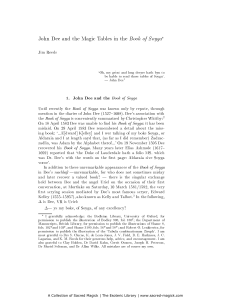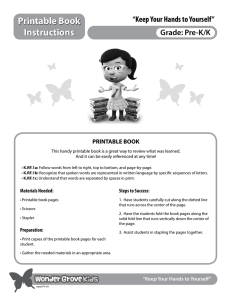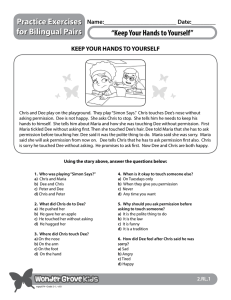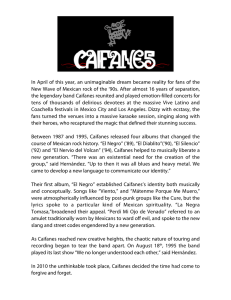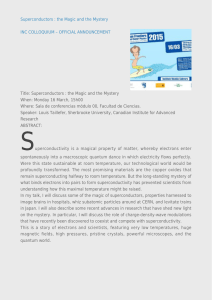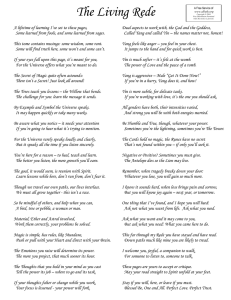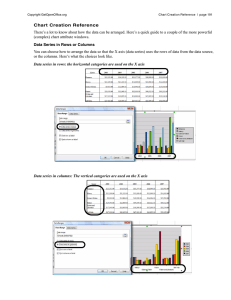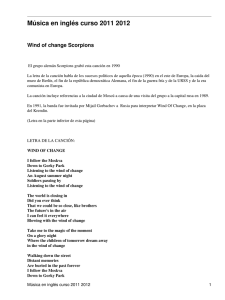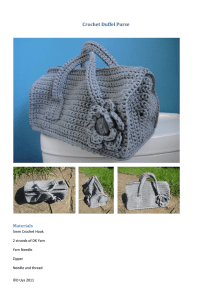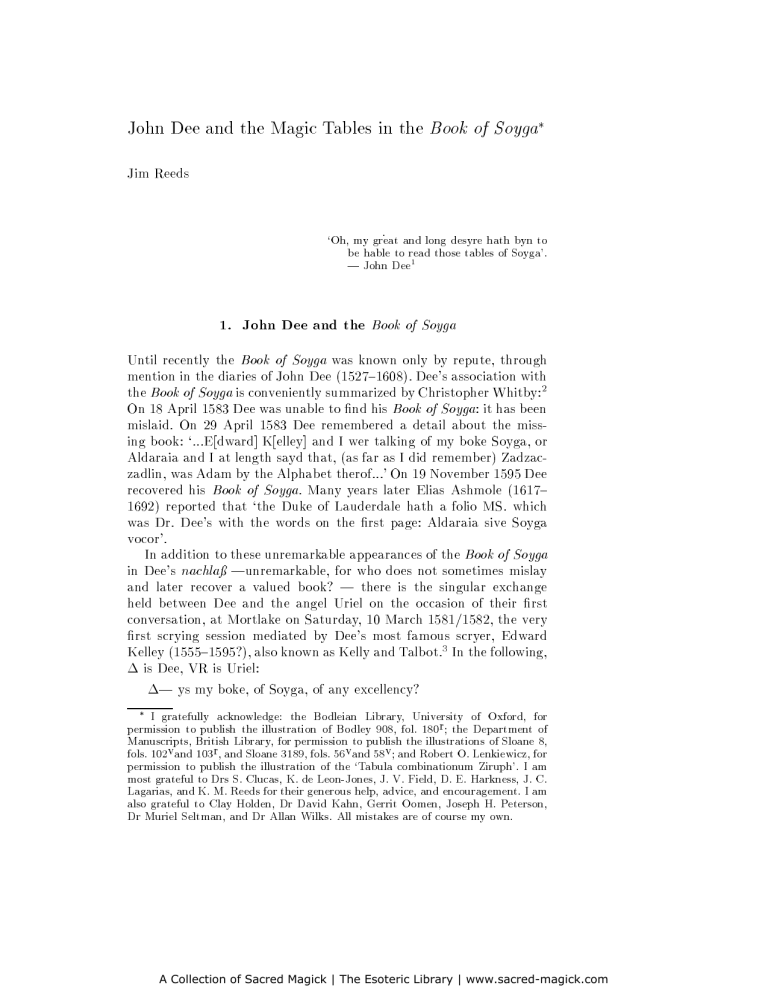
John Dee and the Magic Tables in the Book of Soyga
Jim Reeds
`Oh, my great and long desyre hath byn to
be hable to read
those tables of Soyga'.
| John Dee1
1. John Dee and the Book of Soyga
Until recently the Book of Soyga was known only by repute, through
mention in the diaries of John Dee (1527{1608). Dee's association with
the Book of Soyga is conveniently summarized by Christopher Whitby:
On 18 April 1583 Dee was unable to nd his Book of Soyga: it has been
mislaid. On 29 April 1583 Dee remembered a detail about the missing book: `...E[dward] K[elley] and I wer talking of my boke Soyga, or
Aldaraia and I at length sayd that, (as far as I did remember) Zadzaczadlin, was Adam by the Alphabet therof...' On 19 November 1595 Dee
recovered his Book of Soyga. Many years later Elias Ashmole (1617{
1692) reported that `the Duke of Lauderdale hath a folio MS. which
was Dr. Dee's with the words on the rst page: Aldaraia sive Soyga
vocor'.
In addition to these unremarkable appearances of the Book of Soyga
in Dee's nachla |unremarkable, for who does not sometimes mislay
and later recover a valued book? | there is the singular exchange
held between Dee and the angel Uriel on the occasion of their rst
conversation, at Mortlake on Saturday, 10 March 1581/1582, the very
rst scrying session mediated by Dee's most famous scryer, Edward
Kelley (1555{1595?), also known as Kelly and Talbot. In the following,
is Dee, VR is Uriel:
| ys my boke, of Soyga, of any excellency?
2
3
I gratefully acknowledge: the Bodleian Library, University of Oxford, for
permission to publish the illustration of Bodley 908, fol. 180r; the Department of
Manuscripts, British Library, for permission to publish the illustrations of Sloane 8,
fols. 102vand 103r, and Sloane 3189, fols. 56vand 58v; and Robert O. Lenkiewicz, for
permission to publish the illustration of the `Tabula combinationum Ziruph'. I am
most grateful to Drs S. Clucas, K. de Leon-Jones, J. V. Field, D. E. Harkness, J. C.
Lagarias, and K. M. Reeds for their generous help, advice, and encouragement. I am
also grateful to Clay Holden, Dr David Kahn, Gerrit Oomen, Joseph H. Peterson,
Dr Muriel Seltman, and Dr Allan Wilks. All mistakes are of course my own.
2
J. Reeds
VR| Liber ille, erat Ada[m]e in Paradiso reuelatus, per Angelos
Dei bonos. [That book was revealed to Adam in Paradise by God's
good angels.]
| Will you give me any instructions, how I may read those Tables
of Soyga?
VR| I can|But solus Michael illius libri est interpretator. [Only
Michael is the interpreter of that book.]
| I was told, that after I could read that boke, I shold liue but
two yeres and a half.
VR| Thow shallt liue an Hundred and od yeres.
| What may I, or must I do, to haue the sight, and presence, of
Michael, that blessed Angel?
VR| Presentias n[ost]ras postulate et invocate, sinceritate et
humilitate. Et Anchor, Anachor, et Anilos, non sunt in hunc lapidem invocandi. [Request and invoke our presence with sincerity and
humility. Anchor, Anachor and Anilos are not to be called into this
stone.]
| Oh, my great and long desyre hath byn to be hable to read
those tables of Soyga.
VR| Haec maxime respiciunt Michaelem. Michael est Angelus, qui
illuminat gressus tuos. Et haec revelantur in virtute et veritate non
vi. [These things are mostly to do with Michael. Michael is the angel
who illuminates your steps. And these things are revealed in virtue
and truth and not by force.]
| Is there any speciall tyme, or howre to be observed, to deale
for the enioying of Michael?
VR| Omnis hora, est hora nobis. [Every hour is ours.] ...
To summarize: Uriel con rms Dee's high estimation of the Book of
Soyga's value. Dee wants angelic help in understanding his Book of
Soyga, but only the angel Michael is cleared to talk about this topic. If,
as some scholars believe, Kelley was a charlatan, then here we nd him
(in the voice of Uriel) being characteristically evasive. As a newcomer
to Dee's household he does not want to commit himself to any more
speci c statements about the Book of Soyga, about which he knows
very little beyond the fact that it fascinates Dee.
There things rested for roughly four centuries. Dee prized his Book
of Soyga, but since the book was lost, modern scholars could only guess
about its contents and possible in uence on Dee's magic system, especially for the version in his Book of Enoch.
But then in 1994 Deborah Harkness | like the hero of Poe's `The
Purloined Letter' | located not one but two copies in the obvious
4
5
6
pap11send.tex; 7/05/1998; 9:04; no v.; p.2
3
places, in this case in two of England's greatest libraries. They had
been catalogued under the title Aldaraia instead of Soyga.
At last we can examine the Book of Soyga, and in particular its
tables, and see for ourselves what it was that Dee prized so highly.
The Book of Soyga is an anonymous late-mediaeval or early modern
Latin magical work extant in two sixteenth century manuscript copies:
one in the Bodleian Library, which I refer to as Bodley 908, and the
other in the British Library, which I refer to as Sloane 8. Since there is
as yet no edition or translation of either of the two manuscripts for me
to refer to, nor even a synopsis of their contents, I o er the following
brief description.
The Sloane 8 copy (but not the Bodley 908 one) bears the title
Aldaraia sive Soyga vocor at the head of the text and on the leaf preceding the text, both in the same hand as the text, tting Ashmole's
description. Sloane 8's preceding leaf also bears the description Tractatus Astrologico Magicus, written in a di erent hand. Both copies contain the equation of `Adam' with `Zadzaczadlin', so there can be no
doubt that Harkness's Book of Soyga is closely related to Dee's Book
of Soyga; on Ashmole's Aldaraia sive Soyga vocor evidence, and based
on the arguments I present at the end of section 5, it is easy to guess
that Sloane 8 was in fact Dee's copy of the Book of Soyga.
The 197 leaves of Bodley 908 contain three named works, Liber
Aldaraia, Liber Radiorum, and Liber decimus septimus (of 95, 65, and
2 leaves, respectively) as well as a number of shorter unnamed works
totalling about 10 leaves. The nal 18 leaves contain the tables that are
the subject of this paper. Sloane 8 has 147 leaves, and seems largely
identical with Bodley 908, except that the tables occupy 36 leaves and
the Liber Radiorum is present only in a 2 leaf truncated `executive
summary' version.
A cursory inspection of the Book of Soyga shows it is concerned
with astrology and demonology, with long lists of conjunctions, lunar
mansions, names and genealogies of angels, and invocations, not much
di erent from those found, say, in pseudo-Agrippa. A single example,
of a list of spirits of the air, is illustrative of the whole:
Adracty, Adaci, Adai, Teroccot, Terocot, Tercot, Herm, Hermzm,
Hermzisco, Cotzi, Cotzizi, Cotzizizin, Zinzicon, Ginzecohon, Ginchecon, Saradon, Sardon, Sardeon, Belzebuc, Belzscup, Belcupe,
Saraduc, Sarcud, Carc, Sathanas, Satnas, Sacsan, Contion, Conoi,
Conoison, Satnei, Sapnn, Sappi, Danarcas, Dancas, Dancasnar.
Some of the spells or incantations have a vaguely Christian or alchemical air to them, as `Petra Ouis Angelus Agnus Lapis Sponsus' and
`Diuinitas Christus Venturus Iustorum Humanitatis Vnitas', but the
Magic Tables in the Book of Soyga
7
8
9
10
11
12
13
pap11send.tex; 7/05/1998; 9:04; no v.; p.3
4
overall impression is that it is no more an alchemical treatise than it is
a devotional work.
Several features of the Book of Soyga seem worth particular mention,
as being untypical of a standard late mediaeval or Renaissance magical
work, or of the run-of-the-mill necromancy handbook. In contrast
to most mediaeval or Renaissance works, the text has extremely few
references to known authors or personalities. There are no recognizable
auctores. Other than the occasional mention of a few Old Testament
names, and two references to Libro Geber, and a puzzling marginal gloss
`Steganographia' in the same hand as the text, which is presumably a
reference to the work of Johannes Trithemius (1462{1516), there are
no references to recognizable personalities.
Instead, it makes numerous references to what are presumably mediaeval magical treatises, works such as liber E, liber Os, liber dignus, liber
Sipal, liber Munob, and the like.
Throughout the book much importance is placed on writing words
backwards. This can be seen in some of the titles mentioned above:
Sipal backwards is Lapis, and Munob reversed is Bonum. Phrases such
as `Retap Retson' occur throughout. This principle is re ected in the
form of the tables, as discussed below. The name of the work, Soyga,
is itself explained to be `Agyos, literis transvectis'.
Throughout the book there is a preoccupation with letters and combinations of letters, assignments of numerical values to letters, assigning
letters to planets and to elements, listing combinations of letters associated with houses of the moon, recombining letters and syllables in
incantations to form new magic words, listing new names for the 23
letters of the Latin alphabet, sometimes taken in reversed Z through A
order, listing new symbols for the 23 letters, and so on.
And, towards the end of the book there is the set of thirty-six large
square tables, described in section 2 of this paper, lled with a seemingly random jumble of letters. (One of these is illustrated in my Plates
I and II.) These tables do not appear to be like any illustrated in, say,
Shumaker's survey of mediaeval and early modern magic works.
The Book of Soyga's preoccupation with letters, alphabet arithmetic, Hebrew-like backwards writing, and so on, is of course characteristic of the new Cabalistic magic which became popular in the
sixteenth century, exempli ed by the great compilation of Agrippa
of Nettesheim (1486{1535), and borrowing authority both from the
Renaissance humanist interest in the Kabbalah expressed by such gures as Pico and Reuchlin and from the supposed Biblical antiquity
of the Kabbalah. Although large square tables are not themselves a
characteristic feature of the traditional Kabbalah, they had by Agrippa's time become an integral part of the Christian magical Cabala.
J. Reeds
14
15
16
17
18
19
pap11send.tex; 7/05/1998; 9:04; no v.; p.4
5
Such a work must have appealed to Dee since it encompassed so
many of the ingredients associated with early modern magical and
Christian Cabalist texts; we know the tables in the Book of Soyga
excited John Dee's interest, as seen in the dialogue with Uriel. They
certainly also excited mine as a professional cryptologist. Were they, I
wondered, lled with a random (and hence pointless) selection of letters, or were they a cryptogram (with a hidden `plain text' meaning,
which might at least in principle be recoverable by cryptanalysis), or
was there some other structure or pattern to them? I approached the
tables as I would any cryptographic problem, rst transcribing the data
and entering it into the computer, and then trying out what I knew
of the bag of code-breakers' tricks. The results, which I describe in
sections 3 through 6, were unexpectedly gratifying.
This paper, then, indirectly addresses the question of the Book of
Soyga's possible in uence on Dee by examining and comparing the
form (or method of construction) of the tables in the Book of Soyga
and those found in other early modern magic tables (including Dee's
and Agrippa's), rather than their function (i.e., purpose or method of
use).
Magic Tables in the Book of Soyga
2. The Magic Tables of the Book of Soyga
The Book of Soyga contains thirty-six tables; each table is a square grid
of 36 rows and columns; each grid cell contains a letter of the Latin
alphabet. These tables turn out to be formed by a completely deterministic calculation method, or algorithm, starting from an arbitrary
`code word' for each table. This construction algorithm is so intricate
that it is unlikely that its presence would be detected on casual examination of the tables.
Each of the thirty-six tables is headed with a number and a label.
I summarize these in my Table I. For convenience I will refer to them
as T1, T2, and so on. T1 through T12 are labelled with the signs of
the zodiac, Aries through Pisces; as are T13 through T24. T25 through
T31 are labelled with the seven planet names, and T32 through T35
with the four element names. T36 is labelled with the word `Magistri'.
See my Plates I and II for the Bodley 908 and Sloane 8 versions of T1
`Aries'.
Eight of these tables also appear copied in Dee's notebook, the Book
of Enoch, joined in pairs: `The First Table' in the Book of Enoch is a
72-row table, lling both pages of an opening, the rst 36 rows of which
are Soyga's T1 and the last 36 rows of which are Soyga's T13, the two
20
pap11send.tex; 7/05/1998; 9:04; no v.; p.5
6
J. Reeds
Table I. Soyga Tables.
Table
1
2
3
4
5
6
7
8
9
10
11
12
13
14
15
16
17
18
19
20
21
22
23
24
25
26
27
28
29
30
31
32
33
34
35
36
label
Aries
Taurus
Gemini
Cancer
Leo
Virgo
Libra
Scorpio
Sagitarius
Capricornus
Aquarius
Pisces
Aries
Taurus
Gemini
Cancer
Leo
Virgo
Libra
Scorpio
Sagitarius
Capricornus
Aquarius
Pisces
Saturni
Jovis
Martis
Solis
Veneris
Mercurii
Lunae
Ignis
Aeris
Aquae
Terrai
Magistri
code word Bodley 908
NISRAM
180r
ROELER
180v
IOMIOT
181r
ISIAPO
181v
ORRASE
182r
OSACUE
182v
XUAUIR
183r
RAOSAC
183v
RSADUA
184r
ATROGA
184v
SDUOLO
185r
ARICAA
185v
MARSIN
186r
RELEOR
186v
TOIMOI
187r
OPAISI
187v
ESARRO
188r
EUCASO
188v
RIUAUX
189r
CASOAR
189v
AUDASR
190r
AGORTA
190v
OLOUDS
191r
AACIRA
191v
OSRESO
192r
NIEBOA
192v
OIAIAE
193r
ITIABA
193v
ADAMIS
194r
REUELA
194v
UISEUA
195r
MERONF
195v
ILIOSU
196r
OYNIND
196v
IASULA
197r
MOYSES
197v
location in:
Sloane 8 Sloane 3189
102v/103r
58v
v
r
103 /104
60v
v
r
104 /105
62v
v
r
105 /106
64v
v
r
106 /107
107v/108r
108v/109r
109v/110r
110v/111r
111v/112r
112v/113r
113v/114r
114v/115r
59r
115v/116r
61r
116v/117r
63r
117v/118r
65r
118v/119r
119v/120r
120v/121r
121v/122r
122v/123r
123v/124r
124v/125r
125v/126r
126v/127r
127v/128r
128v/129r
129v/130r
130v/131r
131v/132r
132v/133r
133v/134r
134v/135r
135v/136r
136v/137r
137v/138r
pap11send.tex; 7/05/1998; 9:04; no v.; p.6
7
`Aries' tables, and so on, as indicated in my Table I. See my Plate III
for the Book of Enoch version of T1 `Aries'.
The tables are written with italic letters, mostly lower case, written
into a neatly pencilled regular grid. In Bodley 908 the grid cells measure approximately one quarter of an inch, so a complete table ts on
one page. In Sloane 8 the grid cells are approximately one third of an
inch in size, and each table occupies the two facing pages of an opening.
In each book there is occasional use of the short s; much more common is the long s. The writing becomes more even after the rst few
tables, with greatly diminished use of upper case letters, as if the copyist became accustomed to what must have been an unusually irksome
and tedious task of copying completely senseless data which o ered no
obvious contextual clues for correcting mistakes. In Bodley 908 upper
case L is used exclusively, presumably to avoid confusion with long s.
In Sloane 8 lower case l is used exclusively.
The handwriting in Bodley 908 is quite even, and pains seem to have
been taken to make the letters clearly distinguishable. The handwriting
in Sloane 8 is less clear, so that n and u are often hard to tell apart, as
are the pairs c/e and l/i. Sloane 8 shows obvious signs of proofreading,
with dots, double dots, and cup strokes marking errors or doubtful
readings. Occasionally a cell contains, in addition to its main letter,
a tiny f followed by another tiny letter; I surmise f means falso and
the following letter is the suggested correction. Some corrections seem
to have been made by erasure and overwriting; the handwriting also
seems to change part way through.
The left hand margin in each table is special. Each table has a `code
word', e.g., T1 `Aries' has code word NISRAM. The left margin is
composed entirely of the code word and the reversed code word, e.g.,
NISRAM MARSIN NISRAM MARSIN ... repeated until the margin is
lled.
The code words are listed in the third column of my Table I. All
thirty-six of them are exactly 6 letters long. The treatise in the Book
of Soyga which discusses the tables, `Liber Radiorum', has a series of
paragraphs mentioning the code words for twenty-three of the tables,
together with number sequences which stand in unknown relation to
the words.
Note that the code words for T13{T24 are the reverses of those of
the corresponding T1{T12. Thus, T1 `Aries' has code word NISRAM
and T13, also `Aries', has code word MARSIN.
In Bodley 908, T36 `Magistri' has a blank 13th line|the rst line
after the rst complete MOYSES/SESYOM cycle on the left. The
Sloane 8 version the table has the same 35 non-blank lines, but they
have `closed ranks' so it is the last line of 36 which is blank.
Magic Tables in the Book of Soyga
21
22
pap11send.tex; 7/05/1998; 9:04; no v.; p.7
8
J. Reeds
In general, the rst four or ve rows of the tables appear very repetitious. Often the rst row or two consist entirely of endless repetitions
of a given two letter `motif', followed by two or three rows of repetitions
of a 4 letter motif, with maybe another row or so consisting of repetitions of a 12 letter pattern. But these repetitions do not start until one
has gone some distance into the row; with each successive row, one has
to go further.
This may be seen in T1 `Aries', shown in Plates I and II, where the
rst three lines soon fall into repetitions of the 4 letter motifs dizb,
lytr, and xiba, respectively, and the next two rows into repetitions
of the 12 letter motifs qsrnylfdfzly and ohqtauiducis, respectively.
Many of these motifs are found in several of the tables.
A few tables (like T5 `Leo') have a vast triangular area of repeats
of yoyo:
oyoyoyoyoyoyoyoyoyoyoyoyoyoyoyoyoyoy
rkfaqtyoyoyoyoyoyoyoyoyoyoyoyoyoyoyo
rxxqnkoyoyoyoyoyoyoyoyoyoyoyoyoyoyoy
azzsxbqtyoyoyoyoyoyoyoyoyoyoyoyoyoyo
sheimasddtguoyoyoyoyoyoyoyoyoyoyoyoy
eyuaoiismspkfaqtyoyoyoyoyoyoyoyoyoyo
enlxflfudzrxxqnkoyoyoyoyoyoyoyoyoyoy
sxcahqczfbtfzsxbqtyoyoyoyoyoyoyoyoyo
azepxhheurgmyknqnkoyoyoyoyoyoyoyoyoy
rlbriyzycuyddpotxbqtyoyoyoyoyoyoyoyo
ryrezabirhdiszeknqnkoyoyoyoyoyoyoyoy
ogzgfceztqalpntsxhssyoyoyoyoyoyoyoyo
opnxxsnodxqhuekknykkoyoyoyoyoyoyoyoy
rcqsfueesfsqrqgqrossyoyoyoyoyoyoyoyo
roauxmdkkxkhyhmpzqphdtgtguoyoyoyoyoy
aqxmudiamubkoqifbszktdmspkfaqtyoyoyo
sazoesrmlrnaqnzhgabmsmlpeahfsddtguoy
...
Various other less pronounced repetitious structures can also be seen
in the tables.
3. Analysis of Tables
Because Bodley 908's tables seemed more legible, I transcribed them
rst. The transcribed text was entered into the computer with many
measures taken to prevent or detect copying errors. Once it was entered,
pap11send.tex; 7/05/1998; 9:04; no v.; p.8
9
repetitions in the text could be sought, patterns counted, and proof
sheets printed.
In the course of this work it was noticed that in the vast majority of
cases where a pair of adjacent m's appeared, the letter above the second
Magic Tables in the Book of Soyga
m was usually
ally
in a
n
m
m
an n. That is, the pattern
m
m
was almost always actu-
. This led to a tabulation of all triplets of letters occurring
N
W
?
X
con guration, and it was found that in a large majority
of cases the letter occupying the X position was predictable from the
letters in the N and W positions. (The names of these variables are
meant to represent the letter at the spot marked by X , the letter to its
North, and the letter to its West.)
This led to discovery of an equation of form
X = N + f (W )
where f (W ) is a function of W and the addition is taken modulo 23.
Here the letters are assigned numerical values according to their positions in the 23 letter Latin alphabet: a = 1, b = 2, ... , u = 20, x =
21, y = 22, z = 23, so that z + 2 = b, etc. The nal ingredient in
this formula, the auxiliary function f , is known to us only by a table
of values determined empirically.
Table II. Auxiliary function values.
W f (W ) W f (W ) W f (W ) W f (W )
a
b
c
d
e
f
2
2
3
5
14
2
g
h
i
k
l
m
6
5
14
15
20
22
n
o
p
q
r
s
14
8
13
20
11
8
t
u
x
y
z
8
15
15
15
2
Expressed another way: a letter is obtained by counting a certain
number of letters after the letter immediately above (i.e., north of) it
in the table. The number of letters to count is determined by the letter
standing to the immediate left (i.e., west). If the letter to the left is
an f, for instance, we are to count two letters past the letter above.
pap11send.tex; 7/05/1998; 9:04; no v.; p.9
10
So, continuing the example, if the letter above is an l, then the letter
J. Reeds
in question must be n, which is 2 letters past l:
l
f
n
. If the end of
the alphabet is reached in this letter counting one starts over at the
beginning, treating a as the letter after z, and so on.
For letters in the top row of a Soyga table, for which there is no N
letter, the following formula holds:
X = W + f (W )
where the addition is again performed modulo 23. That is, for letters in
the top row one applies the rule for letters in the interior of the table,
acting as if the letter appearing to the left also appears above.
4. Directions for Creating the Tables
This, then, is a recipe for recreating the tables, although almost certainly not expressed in the same terms the Soyga author would have
used. Starting with a code word, such as NISRAM, and an empty grid
of 36 rows and columns:
4.1. Left Column:
Write the code word followed by its reverse into the cells of the left
hand column, starting at the top and working downwards, repeating
the process until the column is full.
4.2. Top Row:
Fill in the remaining 35 cells of the top line, working from left to right,
repeatedly applying the formula X = W + f (W ):
In our example, the rst application of this formula yields n + f (n),
that is, the letter f (n) = 14 places after n in the 23 letter alphabet,
which is d. (Thus: n is the 13th letter; 13 + 14 = 27; reduced modulo
23, 27 is 4, which is d.) Write the letter d in the second cell in the top
row, just to the right of the n of NISRAM.
The second application yields d + f (d). Since f (d) = 5, this gives us
i, the fth letter after d. Write an i in the third cell of the top row.
The third application yields i + f (i). Since f (i) = 14, this gives us
z, the 14th letter after i. Write a z in the fourth cell of the top row.
The fourth application yields z + f (z) = 23 + 2 = 25 = 2 = b; put
a b in the fth cell.
pap11send.tex; 7/05/1998; 9:04; no v.; p.10
11
The fth application yields b + f (b)= 2 + 2 = 4 = d; put a d in the
sixth cell. At this point we have fallen into a cycle: the next application
yields d + f (d) which we have already seen before is i, and the rest of
the rst row will continue to repeat dizb dizb...
At this point the top few rows of the partially lled in table will
look like this:
Magic Tables in the Book of Soyga
ndizbdizbdizbdizbdizbdizbdizbdizbdiz
i...................................
s...................................
r...................................
4.3. Interior of Table:
Now, starting with the second row and working left to right within rows,
ll in the interior cells as follows. With each blank cell encountered, if
the work has progressed in normal European page-reading order, the
cell just above the blank cell and the cell to the left have both been lled
in. Call the letters appearing in those cells N and W , respectively, and
use the formula N + f (W ) to determine what to write into the blank
cell under consideration.
For example, the rst blank cell in row 2 is the second cell. It has a
d above it and an i to its left. So the letter d + f (i) = 4 + 14 = 18 =
s is written in that blank cell.
The next cell, cell 3, in row 2 has an i above it and an s to its left
(the s which we just wrote). So we put i + f (s) = 9 + 8 = 17 = r in
cell 3 of row 2. The next cell gets z + f (r) = 23 + 11 = 11 =l, and so
on. The top few rows now look like this:
ndizbdizbdizbdizbdizbdizbdizbdizbdiz
isrl................................
s...................................
This process, carried out row by row, left to right, will eventually
ll the table.
Alternatively, instead of working row by row, left to right in each
row, as described here, one could equivalently work column by column,
working downwards within each column. The nal results would be the
same.
Of course I make no claim that the Soyga author intentionally used
my X = N + f (W ) formula. Whatever means were actually used to
construct the tables clearly had this formula's mathematical structure
implicitly `built in', but we can only guess at its implementation. The
pap11send.tex; 7/05/1998; 9:04; no v.; p.11
12
arithmetic modulo 23, for instance, could have been e ected equally
well by paper-and-pencil computations, by consultation of charts, by
letter counting on nger tips, or by the use of Lullian wheels.
J. Reeds
5. Error Analysis and Genealogy
In fact the tables found in the two extant manuscripts of the Book
of Soyga are not identical with those I produced by a computer programmed to carry out the above rules, starting with the same code
words as in the manuscripts. This is for two reasons:
1. The law of formation for the tables is suciently intricate that
the Soyga author occasionally made mistakes in working out the
original tables.
2. The copyists made new mistakes when transcribing so much apparently unpatterned text.
Fortunately for us, these two kinds of errors have radically di erent
consequences. If a cell in the original is miscalculated, the mistake spoils
the calculation of the cells to its right and below it, resulting in an
avalanche of error with an easily recognizable rectangular shape. A
mere copying error, however, will not have a cumulative e ect, and will
be classi able into one of several familiar types: transposition, deletion,
eye skip, and replacement.
In short, the constraints placed on the tables by the X = N + f (W )
formula allow an aggressive form of textual emendation of the received
tables in Bodley 908 and Sloane 8. A similar technique has been used to
trace copying of logarithm tables by Charles Babbage (1792{1871), but
is of course not generally applicable. Only texts with a well-de ned
mathematical structure are amenable to this method of detecting and
correcting errors of generation and transcription.
23
5.1. Principles of Error Diagnosis: An Artificial Example
This can all be seen in an arti cial example, concocted so as to display
every kind of pathology in the rst few lines of the table. Suppose the
code word is SARTON. Ideally, the rst few lines of the table would be
scfhndizbdizbdizbdizbdizbdizbdizbdiz
aeuzprupprupprupprupprupprupprupprup
rqrlmqrcsbygxilmobygxilmobygxilmobyg
tattuhyscenxnzncrnnxnzncrnnxnzncrnnx
oiklrtgaetxndedhyedcqueredsfpndhyedc
pap11send.tex; 7/05/1998; 9:04; no v.; p.12
Magic Tables in the Book of Soyga
13
nzmkikyqbxnditmgetmbsetbgkkxgtmgetmb
noublgeghcqalqixuliqpsdgnamuylixuliq
oymanxuyzeggrdofycmpeispcdrhdqfzycmp
tgsidczabgnxisyxolifgphusmqesahenrzr
rscmcfbcexemhzazqhoopeymrzsnipxueheh
...
Call this the ideal original table. Suppose, however, that in working
this out a mistake was made: an e was put down instead of a p in the
fth cell of the second line. This mistaken letter will cause mistaken
values to be calculated for the sixth cell of the second line and for the
fth cell of the third line, and those mistakes will beget others. The
resulting actual original table will be (with the erroneous e capitalized)
scfhndizbdizbdizbdizbdizbdizbdizbdiz
aeuzEsrlytrlytrlytrlytrlytrlytrlytrl
rqrlbuibaxibaxibaxibaxibaxibaxibaxib
tattkmhggdokqsrnplfdfzlyqsrnplfdfzly
oiklgsqdmcrxhztxgrrpthqtauiducisohqt
nzmkykhicftfkpimftbrgoaxqruterukfkha
noubamgpqcyxbrudlqyixfcasbylbteahpxq
oymacpugysgdgzyttaalsolxkrkcekuqefzs
tgsirczinixtpnnklxqhzqhcnhpqbmtagmyk
rscmqzblkazxgtxbnmpxpfksxzrdgsdficbm
...
Finally, suppose we receive this table, derived from the original but
with a variety of copying errors:
scfhudizbdizbdhzbdizbdizbdkzbdizbdiz
aeuzefrlytrlyutlyttlyrtlyttlytrlytrl
rqrlbnibaxibaxibaxibxibaxibaxiibaxib
rattkmhggdokqstnplfdfzlyqfrnplfdfzly
oikglsqdmcrxhztxgrrpthqranidueisohqt
nzmkykhicstfkpimstyixfeafbylbtcahpxq
uoubamgpqpyxbiudlqalsolxkrkcckuqefzf
oymacpugyfgdgzyrtaqhzqhcnhpqbmtagmek
tgfirczinixtpnnzlxqhzqhcnhpqbmtagmyk
rfcmqzblkazxgtxbnmpxpsksxztdgsdsicbm
...
Our task is to recover the ideal original and actual original and
diagnose the copying errors.
pap11send.tex; 7/05/1998; 9:04; no v.; p.13
14
J. Reeds
First we inspect the left margin, where we see SARRON UOTR...
etc, which is a damaged version of SARTON NOTRAS etc.; the code
word is SARTON. (The left margin contains in all six copies | forward
and reversed | of the code word, so in practice there is no doubt about
what the code word is.)
From this we work out the ideal original table, and examine those
positions where the received table di ers from it. This diagram displays
places where the received table agrees with the ideal original with a dot
and places where they disagree with the value seen in the received table:
....u.........h...........k.........
....efrlytrlyutlyttly.tlyttlytrlytrl
....bnibaxibaxibaxib..baxiba..ibaxib
r...kmhggdokqstnplfdf.lyqfrnplfdfzly
...glsqdmcrxhztxgrrpthq.anidueisohqt
....y.hicstfkpims.yixfeafbylb.cahpxq
u...amgpqpyxbiudlqalsolxkrkcckuqefzf
....cp.gyf.dgzyrtaqhzqhcnhpqbmtagmek
..f.r..inixtpnnzlxqhzq.cnhpqbmtagmyk
.f..qz.lkazxgtxbnmpx.sksx.tdgsdsicbm
...
Here we see an essentially solid rectangular region of disagreement,
starting in the fth cell of row 2, with the value e, which is due to an
error in the original. The `pepper and salt' pattern of sporadic disagreements elsewhere is characteristic of copying errors. So we conclude that
an e was put down by mistake in row 2, cell 5 in the original.
Now we work out the corresponding putative original, and display
the disagreements between it and the received copy:
....u.........h...........k.........
.....f.......ut...t..rt...t.........
.....n..............xibaxibaxi......
r.............t..........f..........
...gl..................r.n...e......
.........s......s.yixfeafbylbtcahpxq
u........p...i....alsolxkrkcckuqefzf
.........f.....r..qhzqhcnhpqbmtagmek
..f............z....................
...
Since the remaining rectangular regions of disagreement do not reach
to the bottom of the table, we conclude that they are not due to errors
in the original. (Further examination will show they are due to eye
pap11send.tex; 7/05/1998; 9:04; no v.; p.14
15
skip.) No further errors seem to have been made in the original, so our
putative original table is nished.
We are now in a position to diagnose the copying errors. The mistakes in cells 21 through 30 of line 3 are easily seen to be due to elision
of an a from one of the repeating baxi groups; the pattern ends on
the right foot again in cell 31 by the insertion of an extra i. We might
term this a horizontal eye skip error. The errors in cells 19 through 36
in lines 6, 7, and 8 are seen to result from a vertical eye skip error, as
follows. The rightmost 18 cells of lines 6, 7, 8, and 9 of the original are
Magic Tables in the Book of Soyga
brgoaxqruterukfkha
yixfcasbylbteahpxq
alsolxkrkcekuqefzs
qhzqhcnhpqbmtagmyk
and of the received copy are
yixfeafbylbtcahpxq
alsolxkrkcckuqefzf
qhzqhcnhpqbmtagmek
qhzqhcnhpqbmtagmyk
so we see that the copyist deleted the right half of line 6 and duplicated
the right half of line 9. There is a transposition error in row 5, cells 4
and 5: the original has lg and the copy has gl. The remaining errors
are simple replacements of one letter by another.
5.2. Summary of Actual Errors
In fact all of the types of errors illustrated above occur in both the
Sloane 8 and Bodley 908 versions of the tables. There seems to have
been one set of original tables which I call A. Our extant versions,
Bodley 908 and Sloane 8, seem to have been derived independently
from a awed intermediate version which I call C.
pap11send.tex; 7/05/1998; 9:04; no v.; p.15
16
J. Reeds
Table III. Errors in Originals.
Table Row/Col. Err.
T5
15 / 24
t
T8
28 / 25
r
T10
18 / 11
t
T12
15 / 9
y
T13
18 / 2
t
T19
19 / 29
e
T29
18 / 11
m
T32
6 / 25
l
T35
19 / 23
d
Row/Col. Err.
20 / 28
17 / 16
7 / 24
Row/Col. Err.
g
h
e
34 / 27
k
A
?
C
Bodley 908
A
A
A
U
A
Sloane 8
The originals A were constructed with the code words as listed in my
Table I, by application of the N + f (W ) formula; the errors in applying
the formula are listed in my Table III. Since errors in applying the
N + f (W ) formula propagate and spoil everything below and to the
right of the error locus, we can be sure that this is the complete list of
errors in A. Out of the 46,656 cells in the complete set of tables, only
13 errors were made in applying the formula.
The alternative, that Bodley 908 and Sloane 8 did not share a common original, would require us to believe that exactly these same particular errors (and no others) were committed in working out the originals for both Bodley 908 and for Sloane 8. This is so unlikely under
any reasonable model for errors that I reject this alternative in favour
of a single shared common original A.
pap11send.tex; 7/05/1998; 9:04; no v.; p.16
Magic Tables in the Book of Soyga
17
Table IV. Transposition Errors.
Table Row Col. Is
T3
22 29 kq
T12
6
8 cp
T25
14 34 ms
T30
33 28 nm
T31
35 16 lf
T35
22 21 nh
T35
27 34 rs
Ought
qk
pc
sm
mn
fl
hn
sr
Bodley 908
Sloane 8
Bodley 908
Bodley 908 Sloane 8
Sloane 8
Bodley 908 Sloane 8
Bodley 908 Sloane 8
Table V. Summary of cell reading disagreements.
Type of Disagreement
Raw Censored
A, Bodley 908, and Sloane 8 all di er
10
6
A and Bodley 908 same; Sloane 8 di erent
266
115
A and Sloane 8 same; Bodley 908 di erent
144
75
Bodley 908 and Sloane 8 same; A di erent
394
223
A, Bodley 908, and Sloane 8 all agree
45541
45936
A number of gross eye skip errors were committed in the descent of
Bodley 908 and Sloane 8 from A. In Bodley 908's version of T2, row
3, cells 20{35 read axibaxibaxibaxib instead of xibaxibaxibaxiba;
that is, an a was inserted at cell 20. In both Bodley 908's and Sloane
8's versions of T24, the right hand half of row 35 was elided and the
right hand half of row 34 was duplicated. In both Bodley 908's and
Sloane 8's versions of T36, row 3, cells 30{36 read baxibax instead of
A's ibaxiba, and row 12 is elided.
I detected seven transposition errors, some unique to Bodley 908
and to Sloane 8, and some shared, as listed in my Table IV.
A tabulation was made of all corresponding places where Sloane 8,
Bodley 908, or A were all legible but failed to give unanimous readings
of cell entries, except for those involved in the gross eye skips noted
above. The tabulation was made again, where all di erences explainable
by mere confusion of i/l, u/n, f/s, e/c, or t/r were censored, in an
attempt to compensate for possible transcription errors on my part
(especially in reading Sloane 8).
The results, in my Table V, again show Bodley 908 and Sloane 8 each
have a large number of unique errors in addition to a larger number
of shared errors. If either of Sloane 8 or Bodley 908 were copied from
the other, the errors unique to the ancestor would have had to have
been corrected in the child. Because the text is incoherent, there is no
pap11send.tex; 7/05/1998; 9:04; no v.; p.17
18
natural `self repair' mechanism analogous to a scribe's knowledge of
orthography or grammar allowing emendation of errors, at least in the
large areas of the tables lacking repeating motifs. If both Bodley 908
and Sloane 8 were independently derived from the original A, the 394
(or 223) shared errors would all be the result of accidental occurrence
of precisely the same mistakes, independently committed in copying
Bodley 908 from A and in copying Sloane 8 from A. This is very unlikely
under any reasonable model of copying errors. So we conclude instead
that both Bodley 908 and Sloane 8 were derived from a common awed
copy, which I call C, of the originals. Because Bodley 908 seems to
have fewer disagreements with A than Sloane 8 does, we conclude that
Bodley 908 is a more accurate copy of C than Sloane 8 is. Overall, there
seems to be a 3/4% copying error rate in going from A to C, a 1/2%
error rate in going from C to Sloane 8, and a 1/3% error rate in going
from C to Bodley 908.
The same techniques can be used to see what relation Dee's copy
of the eight Soyga tables appearing in Sloane 3189, the Book of Enoch,
has to Bodley 908 and Sloane 8.
In the rst place, the T13 of Sloane 3189 shows the same mistake in
applying the N + f (W ) formula (in row 18, column 2) present in the
T13 of A. Hence even if not copied directly from Bodley 908 or Sloane
8, the Soyga tables in Sloane 3189 are, like those of Bodley 908 and
Sloane 8, ultimately derived from A. A fortiori, they are copies of the
Soyga tables, rather than simply creations inspired by, or in the same
style as, the Soyga tables.
Secondly, the T2 of Sloane 3189 lacks the gross eye skip error found
in row 3 of T3 of Bodley 908. This suggests Sloane 3189 was not copied
from Bodley 908, but not strongly so: the eye skip error occurs in the
repeating baxibaxi area and could have been corrected by a naive but
alert copyist.
Third, looking only at locations where all four of A, Bodley 908,
Sloane 8 and Sloane 3189 supply legible values, I found the results in
my Table VI. The agree-disagree counts seem to make Sloane 3189
slightly but insigni cantly closer to Bodley 908 than to Sloane 8.
Fourth, and more tellingly, the transposition error in T3 of Bodley
908, where there is a kq instead of the correct qk in row 22, is not
present in the T3 of Sloane 3189. Unlike the T2 eye skip error, this
error is well outside the area of repeating motifs, and so uncorrectable
by a naive copyist.
On balance, then, it seems that the Soyga tables in Dee's Book of
Enoch, Sloane 3189, are closer in manuscript transmission to Sloane 8
than to Bodley 908.
J. Reeds
pap11send.tex; 7/05/1998; 9:04; no v.; p.18
Magic Tables in the Book of Soyga
19
Table VI. Summary of cell di erences between Sloane
3189 and A, Bodley 908 and Sloane 8.
Sloane 3189
Raw
Censored
compared with Disagree Agree Disagree Agree
A
288 9877
209 9956
Bodley 908
203 9962
149 10016
Sloane 8
208 9957
155 10010
Assuming that the Sloane 3189 Soyga tables were copied from Sloane
8, the most common copying error was replacing z by x: out of the 477
occurrences of the letter z in the Sloane 8 tables which have corresponding Sloane 3189 versions, it was rendered correctly 441 times, rendered
as an x 34 times, and as a q and an r each once. There are 9 instances
where an i was written instead of a y. Overall, there is a 1.5% copying
error rate from Sloane 8.
Regardless of which particular manuscript the Book of Enoch got
its Soyga table copies from, the questions of why they were copied
and what relation they have to the Enochian system are central to
furthering our understanding of Dee's relation to the Book of Soyga.
On the one hand it is possible that Dee deliberately copied them (or had
them copied) into his notebook (in rearranged sequence: T1, T13, T2,
T14, and so on, so both `Aries' tables were visible on an opening, both
`Taurus' tables visible on the next, etc.) for ready reference, possibly
with motives similar to mine in section 3 of this paper, or possibly in
order to use them in magical operations. This might have happened
some time before 1582, that is, before his `Enochian' period, in which
case their appearance with the Enochian material in Sloane 3189 would
be the accidental result of reuse of a largely blank notebook. On the
other hand, they might have a more direct connection with the Sloane
3189 Enochian material: they might have been revealed the same way
the rest of the Book of Enoch material was (in which case the copying
errors could be attributed either laudably to angelic emendation or
deplorably to mundane data-entry-clerk error), or they might have been
accorded a semi-privileged status, not themselves revealed but worthy
of inclusion as an appendix to the Book of Enoch by a principle of
virtue-by-association. Even though I see no way to use the methods of
this paper to distinguish between these possibilities, I do not hesitate
to speculate in the next section about one possible stylistic connection
between the Soyga tables and the rest of the Book of Enoch.
pap11send.tex; 7/05/1998; 9:04; no v.; p.19
20
J. Reeds
6. Comparison with other tables
Large square tabular arrays of letters are quite common in early modern
magic works, exhibiting a variety of forms as yet unsurveyed in the
scholarly literature. Here I present a brief taxonomy of magic tables
according to their internal structure.
The more usual point of view, represented by Yates, pays primary
attention to the authors' theories of magic and scant attention to the
actual form of the tables:
... in Agrippa's Third Book [on Occult Philosophy] there are elaborate numerical and alphabetical tables for angel-summoning of the
type [my emphasis] which Dee and Kelley used in their operations...
These can be seen in Dee's manuscript `Book of Enoch', British
Museum, Sloane MSS. 3189. Cf. the `Ziruph Tables' in Agrippa's
De occult. phil., III, 24. Agrippa was not Dee's and Kelley's only
source for practical Cabala, but their minds run on these things
within the Agrippan framework.
In fact Dee's tables and Agrippa's have completely di erent forms (as
can be seen by glancing at my Plates IV and V), so Yates must be
using `of the type' to refer to the authors' intentions and not to their
tables' actual appearance or formation.
My tentative taxonomy begins by crudely dividing all square magic
tables into two classes, the small and the large, according to whether
they have, say, fewer than fteen rows and columns or more. Among
the small tables are those with letters forming words when read either
vertically or horizontally, as in the famous square found at Herculaneum,
24
25
S
A
T
O
R
A
R
E
P
O
T
E
N
E
T
O
P
E
R
A
R
O
T
A
S
which are nowadays known as `word squares'. Word square charms have
been in continuous use from Roman times to the present. Many such
squares appear in Abraham ben Simeon's Cabala Mystica, which Patai
concludes | based in part on an analysis of the text in the squares
themselves | was written around 1400.
Small numerical tables like
26
pap11send.tex; 7/05/1998; 9:04; no v.; p.20
21
Magic Tables in the Book of Soyga
11
4
17
10
23
24
12
5
18
6
7
25
13
1
19
20
8
21
14
2
3
16
9
22
15
nowadays known as `magic squares', have also been used since the late
middle ages in Europe and in Asia for far longer as charms or arithmetical amusements. (The numbers in each of the rows, columns,
and two main diagonals all add up to the same sum, in this case 65.)
Such a small numerical square appears in the 1514 print Melencolia I of
Albrecht Durer (1471{1528); many others are to be found in Agrippa's
Book II, where each planet is assigned its own magic square, each square
being presented in both Arabic and equivalent Hebrew numerals.
As far as I know, all large magic tables in mediaeval or early modern sources are alphabetic. We may divide them into unpatterned and
patterned; the latter are subdivided into those in which the form of the
pattern is obvious and those in which the pattern is hidden.
Most of Dee's tables in the Book of Enoch are unpatterned: squares
and lozenge shaped arrays with 49 rows and columns lled with text in
the `Enochian' language described by Laycock and Whitby. One of
these is illustrated in my Plate IV. The text is inscribed in the tables
line by line, left to right, one letter per cell, with no space between
words. The eight Soyga tables appearing in the same book are of course
patterned, but with a hidden pattern; it is tempting to believe that
Dee's favourite table size, 49, was inspired by the size of the Soyga
tables, 36, since 49 = 7 7 is the next perfect square after 36 = 6 6.
Similarly there are 36 Soyga tables and, as Kelley informed Dee on 24
March 1582/1583, there are to be 49 Enochian tables.
There are many large patterned tables in one of Agrippa's Cabalistic
chapters. They include: an angel chart of no interest to us, a `right
table of commutation', an `averse table of commutation', an `irrational
averse table of commutation', a `table of Ziruph', and a `rational table
of Ziruph'.
The three tables of commutation are examples of what are nowadays
known as `Latin squares', N by N tabular arrays of symbols from an
N symbol alphabet | in this case the N = 22 letter Hebrew alphabet
| arranged in such a way that each letter appears just once in each
row and in each column.
It is possible that Agrippa received the idea of the `tabula commutationum recta' from Trithemius. Book 5 of Trithemius's Polygraphia
27
28
29
30
31
32
pap11send.tex; 7/05/1998; 9:04; no v.; p.21
22
(written in 1508 but printed in 1518) contains a `recta transpositionis
tabula' and a `tabula transpositionis aversa' of exactly the same form as
Agrippa's but based on a hybrid 24 letter alphabet formed by adjoining
`w' to the end of the standard 23 letter Latin alphabet. These Latin
squares are of a particularly simple type, where each row is a shift of its
predecessor, giving the table an overall barber-pole pattern of diagonal
stripes.
Agrippa's third table of commutation, the `tabula aversa dicat irrationalis' is a more complex Latin square. The top row and right-hand
vertical margin contain the alphabet in its usual order; the bottom
row and the left-hand vertical margin contain the alphabet in reversed
order. The interior of the table is partially patterned. Most rows contain blocks of letters in consecutive alphabetical order. Because most
of these blocks are shifted by one square from corresponding blocks
in neighbouring rows, much of the area of the table has a diagonally
striped pattern. But there does not seem to be a simple rule specifying
the overall conformation of the table. It seems to be the result of an
attempt to construct a Latin square as diagonally striped as possible,
consistent with the given normal and reversed alphabets appearing in
the margins.
Agrippa's table of Ziruph, illustrated in my Plate V, is possibly
copied from Johann Reuchlin (1455{1522), who in turn owes much
to the thirteenth century Kabbalist Abraham Abula a (1240{1292).
It consists of 22 rows, each with 11 cells per row. In each cell is a
pair of Hebrew letters, placed in such a way that each letter appears
exactly once in each row. Each row represents a reciprocal substitution
alphabet: the letters in each of the 11 pairs are to be substituted for
each other. One of these rows gives the `Atbash' alphabet according
to which the rst and last letters of the Hebrew alphabet (aleph and
taw) are interchanged, the second and second from last (beth and shin),
and so on. Successive rows are obtained by alternately shifting all the
left hand elements of the pairs to the pair to the left or all the right
hand elements to the pair to the right (with a provision for reversing
direction when the end is reached) in a kind of contredanse.
Such substitution alphabets are used in the branch of the practical Cabala known as temurah (permutation) in connection with the
operation of tseruf (combination). The intent is to enlarge the scope
of Cabalistic correspondences between words and phrases: two words
are related not only if they have the same numerical sum, as in usual
gematria, but also if the one is equal to the Atbash-transformed version of the other, and so on. The `rational table of Ziruph' is possibly
Agrippa's invention. The size, shape, and general appearance of this
J. Reeds
33
34
35
36
pap11send.tex; 7/05/1998; 9:04; no v.; p.22
23
table is the same as the Ziruph table, but the pattern by which the
letters shift from row to row is slightly di erent.
Not all large patterned tables appearing in the early modern period
are magical, however. For instance, a manuscript of Thomas Harriot
(1560{1621) contains letter squares intended to illustrate a combinatorial calculation. These tables, like the Soyga tables, are derived from
a key word or phrase, but unlike the Soyga tables, the pattern is completely obvious. Harriot used the key phrases HENRICVS PRINCEPS
FECIT and SILO PRINCEPS FECIT to form squares of 21 and 17
rows respectively. The following arti cial example based on the key
word VERITAS illustrates the pattern. (The key phrase starts at the
centre and emanates in concentric lozenges towards the corners.)
Magic Tables in the Book of Soyga
37
S
A
T
I
T
A
S
A
T
I
R
I
T
A
T
I
R
E
R
I
T
I
R
E
V
E
R
I
T
I
R
E
R
I
T
A
T
I
R
I
T
A
S
A
T
I
T
A
S
Each of these tables is accompanied by a numerical calculation, which
turns out to give the number of ways the given key phrase can be spelled
out in the square, following a path of vertical and horizontal moves to
adjacent cells, starting in the centre and nishing in a corner. (The
present VERITAS specimen has ,80such paths; the general formula is
4 times the binomial coecient nn , when the key phrase has 2n + 1
letters.)
And nally we have the tables in the Book of Soyga as our sole
examples of large patterned tables whose pattern is hidden. None of
the other tables, intricate as they are, have so complex an underlying
pattern as that given by the N + f (W ) formula used in the Book of
Soyga. It is no wonder that Dee found them perplexing.
2
Notes
British Library, MS Sloane 3188, fol. 9r.
All of these examples: Christopher Whitby, John Dee's Actions With Spirits, 2
vols (New York: Garland, 1988), i, pp. 146{147.
3
Scrying, a cooperative magical operation during which privileged visual and
aural information | in this case from angels | is conveyed to the participants,
was much used by Dee. Three di ering views of what `really went on' are presented
1
2
pap11send.tex; 7/05/1998; 9:04; no v.; p.23
24
J. Reeds
in Meric Casaubon, A True and Faithful Relation (London, 1659) (which I have
not seen), in Whitby, Actions with Spirits, i, and in D. E. Harkness, `Shows in the
Showstone: A Theater of Alchemy and Apocalypse in the Angel Conversations of
John Dee (1527{1608/9)', Renaissance Quarterly, 49 (1996), 707{737.
4
John Dee, Spiritual Diaries, Sloane 3188, fol. 9r, transcribed in Whitby, Actions
with Spirits, ii, pp. 17{18 and translated in Whitby, Actions with Spirits, i, pp. 211{
212.
5
A marginal note on Sloane 3188, fol. 9r, transcribed in Whitby, Actions with
Spirits, ii, p. 18, seems to say Kelley and Dee had met for the rst time two days
previous to this: `Note: he had two dayes before made the like demaunde and request
vnto me: but he went away vnsatis ed. For, his coming was to entrap me, yf I had
any dealing with Wicked spirits as he confessed often tymes after...' See my note 16
for evidence of Kelley's continued ignorance of basic facts about the Book of Soyga
a month later.
6
Whitby, Actions with Spirits, i, pp. 146{147; Deborah Elizabeth Harkness,
`The Scienti c Reformation: John Dee and the Restitution of Nature' (unpublished
Ph.D. dissertation, University of California at Davis, 1994), pp. 317{318, 415. Both
guess the Book of Soyga might well have in uenced Dee or Kelley. Harkness, p. 415,
suggests that the Book of Soyga's Adamic association | in particular its use of
an Adamic language, discussed by Uriel and Il, in Sloane 3188, fols. 9r and 89v|
would have especially appealed to Dee. Whitby, Actions with Spirits, i, p. 147, cites
I. R. F. Calder as conjecturing that the Book of Soyga is the Voynich manuscript
(Yale University, Beinecke Rare Book & Manuscript Library, MS 408), the notorious
cipher manuscript described by J. M. Manly, `Roger Bacon and the Voynich MS',
Speculum, 6 (1931), 345{391; if true, this would be a case of solving one mystery by
replacing it with a greater. I see no connection between the two books, other than
their probable ownership by Dee. The Book of Enoch, also called Liber Logaeth and
Liber mysteriorum sextus et sanctus, British Library, MS Sloane 3189, was in e ect
Dee's lab notebook, written concurrently with the Spiritual Diaries, Sloane 3188.
Whitby, Actions with Spirits, i, p. 143, gives a description of its contents.
7
Deborah Harkness, personal communication, 1996, and `The Nexus of Angelology, Eschatology, and Natural Philosophy in John Dee's Angel Conversations and
Library', in this volume.
8
Oxford, Bodleian Library, MS Bodley 908; British Library, MS Sloane 8.
9
This description is based on examination of micro lm copies, not on the manuscripts themselves.
10
`Zadzaczadlin': Bodley 908, fol. 69v and Sloane 8, fol. 70v.
11 Robert Turner, Henry Cornelius Agrippa His Fourth Book of Occult Philosophy
(London, 1655; reprinted London: Askin, 1978).
12
Bodley 908, fol. 51v.
13
Both in Bodley 908, fol. 42r.
14
As described by, say, Richard Kieckhefer, Magic in the Middle Ages (Cambridge:
Cambridge University Press, 1989).
15
`Geber': Bodley 908, fols. 116v and 126r; `Steganographia': Bodley 908 fol.
123v.
16
Bodley 908, fol. 4r; Sloane 8, fol. 6r. But this directly contradicts what the spirit
`Il' said during a scrying session with Edward Kelley and John Dee on Thursday 18
April 1583, as recorded in Dee's Spiritual Diaries, Sloane 3188, fol. 89v, transcribed
in Whitby, Actions with Spirits, ii, p. 332: `Soyga signi eth not Agyos. Soyga alca
miketh.' (Dee's|or Il's|emphasis.) One might take this as evidence of Kelley's
unfamiliarity with the Book of Soyga at this early stage in his residence in Dee's
household.
17
Wayne Shumaker, The Occult Sciences in the Renaissance: A Study in Intellectual Patterns (Berkeley, California: University of California Press, 1972).
pap11send.tex; 7/05/1998; 9:04; no v.; p.24
Magic Tables in the Book of Soyga
25
D. P. Walker, Spiritual and Demonic Magic from Ficino to Campanella, (London: Warburg Institute, 1958) and Frances A. Yates, Giordano Bruno and the Hermetic Tradition (London: Routledge and Kegan Paul, 1964). It is certain that Hermeticism and Cabalism were important formative in uences on early modern magic,
even if Yates's claims about their in uence on early modern science are rejected.
19
Karen de Leon-Jones, personal communication, 1998. I have not found a single
table or chart or discussion of such anywhere in the works I have seen of the two
great modern historians of the Kabbalah, Gershom Scholem and Moshe Idel.
20
In Bodley 908, at fols. 180{197; in Sloane 8, at fols. 102{138; see my Table I.
21
Book of Enoch, Sloane 3189, in four openings of the book, between fols. 58{65,
as shown in my Table I.
22
In Bodley 908, fols. 167r{168v; in Sloane 8, fols. 138v{140v. The Bodley 908
version seems to contain many mistakes.
23
Charles Babbage, `Notice respecting some Errors common to many Tables of
Logarithms', Memoirs of the Astronomical Society, 3 (1827), 65{67, which I have
only seen reprinted in Charles Babbage, The works of Charles Babbage, edited by
Martin Campbell-Kelly, 11 vols (London: W. Pickering, 1987), ii, pp. 67{71. Summarized in Dr Dionysius Lardner, `Babbage's Calculating Engine', Edinburgh Review,
July 1834, no. 120; which I have only seen as reprinted in Charles Babbage and his
Calculating Engines, Selected Writings by Charles Babbage and Others, edited by
Philip Morrison and Emily Morrison (New York: Dover, 1961), pp. 163{224; the
discussion of errors in logarithm tables appears on pp. 177{183.
24 Yates, Giordano Bruno, p. 149 and note. The tables are in Agrippa, De Occulta
Philosophia, iii, 25, not iii, 24.
25
That is, Yates did not care to pay attention to the di erences between the
tables, possibly because she did not know how to. It is also possible that for Yates,
magic tables | unlike texts or images | are not subject to the processes of copying,
emulation, improvement, and confusion; that is, they are neither vehicles for ideas
nor potential sources of evidence in intellectual or cultural history.
26
Raphael Patai, The Jewish Alchemists (Princeton: Princeton University Press,
1994), pp. 277{288.
27 Menso Folkerts, `Zur Fr
uhgeschichte der magischen Quadrate in Westeuropa',
Sudho s Archiv, 65 (1981), 313{338 gives a detailed survey of the genre. Vladimr
Karpenko, `Between Magic and Science: Numerical Magic Squares', Ambix, 40
(1993), 121{128, surveys alchemical magic squares; in this connection, also see Patai,
The Jewish Alchemists, chapter 26.
28
Heinrich Cornelius Agrippa of Nettesheim, De Occulta Philosophia libri tres
(Cologne, 1533). I rely on the edition of V. Perrone Compagni (Leiden: Brill, 1992).
In a supercilious scholium, Shumaker, The Occult Sciences in the Renaissance,p.139,
takes Agrippa to task for a mistake in one of his magic squares. However the mistake
is clearly a typographic error present only in the Arabic numeral form of the square,
and only in the particular edition Shumaker looked at. (Shumaker, p. 158, note
70, seems to say he relies on `Henricus Agrippa ab Nettesheym, Opera (Lugduni,
c. 1650?)', which he understands to be printed in London instead of Lyons!) For
a discussion of Agrippa's magic squares, see K. A. Nowotny, `The construction of
certain seals and characters in the work of Agrippa of Nettesheim', Journal of the
Warburg and Courtauld Institutes, 11 (1949), 46{57 and I. R. F. Calder, `A note on
magic squares in the philosophy of Agrippa of Nettesheim', Journal of the Warburg
and Courtauld Institutes, 11 (1949), 196{199.
29
Donald C. Laycock, The Complete Enochian Dictionary: A Dictionary of the
Angelic Language as Revealed to Dr. John Dee and Edward Kelley, revised edition
(York Beach, Maine: Samuel Weiser, 1994); Whitby, Actions with Spirits, i, pp.
144{146.
18
pap11send.tex; 7/05/1998; 9:04; no v.; p.25
26
J. Reeds
Sloane 3189, fol. 62v, transcribed in Whitby, Actions with Spirits, ii, p. 227.
Apparently one of the tables is not to be written, leaving only 48 to be put in
the Book of Enoch. It is tempting to compare this with the Book of Soyga's T36
`Magistri', which has a missing row.
31
Agrippa, De Occulta Philosophia, iii, 25, sigs. yiir {yiiiir . These tables are surveyed in a modern reissue of the J[ohn] F[rench] translation (London, 1651) of Agrippa: Three Books of Occult Philosophy, edited by Donald Tyson (St. Paul, Minnesota:
Llewellyn Publications, 1993), appendix VII, pp. 762{767.
32
J. Denes and A. D. Keedwell, Latin Squares and their Applications (New York:
Academic Press, 1974).
33
Johannes Trithemius, Polygraphiae libri sex (Oppenheim, 1518), v, sigs. oijr
and oijv. It is barely possible that Trithemius received the idea of such tables from
Agrippa, possibly when they met in the winter of 1509/1510. In 1510 Agrippa sent
Trithemius a draft of his De occulta philosophia which, according to Compagni (p.
58), lacked the chapter containing the Ziruph tables and tables of commutation.
Trithemius's use of the tabula recta is purely cryptographic, and most printed works
on cryptography ever since include such diagrams, often under the name of `Vigenere
table'. Since Agrippa's text does not discuss his tables of commutation it seems more
likely, absent any further direct evidence, that Agrippa copied from Trithemius.
34
Johann Reuchlin, De Arte Cabalistica (Hagenau, 1517), Book III, sig. Nvir;
I rely on the parallel-text translation of M. Goodman and S. Goodman, of 1983,
reissued with introduction by Moshe Idel (Lincoln, Nebraska: University of Nebraska
Press, 1993). For gematria and the Reuchlin-Abula a connection: Gershom Scholem,
`Gematria' in Encyclopaedia Judaica (Jerusalem: Macmillan, 1971) and Gershom
Scholem, Major Trends in Jewish Mysticism, second edition, reissued (New York:
Schocken, 1995), p. 127.
35
A somewhat similar table of reciprocal substitution alphabets occurs in
Giovanni-Battista della Porta, De Occultis Literarum Notis (Naples, 1563) ii, 16; I
rely on a facsimile (Zaragoza: Catedra de Criptografa del Centro Politecnico Superior de la Universidad de Zaragoza, 1996) of the 1593 Montbeliard edition. This is a
cryptographic work, and Porta tables are almost as much a xture in cryptographic
literature as Vigenere tables. Porta's table is based on a 22 letter Latin alphabet
with the letter K omitted. In Porta's table but not in the Ziruph table letters from
the rst half of the alphabet are paired only with letters from the last half.
36
There appears to be one deviation from this pattern. In the seventeenth row of
both Reuchlin's and Agrippa's tables the letters sade and resh are paired, as are tet
and taw. The rule used to produce the rest of the table would pair taw with sade
and pair tet with resh.
37
British Library, Additional MS 6782, fols. 27, 28, with associated calculation
on fol. 57. These are brie y described in John W. Shirley, Thomas Harriot: a Biography (Oxford: Oxford University Press, 1983), pp. 419{420, who apparently did not
understand the calculation on fol. 57. I intend to address these Harriot tables in a
subsequent paper.
30
pap11send.tex; 7/05/1998; 9:04; no v.; p.26
